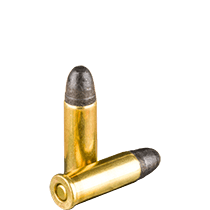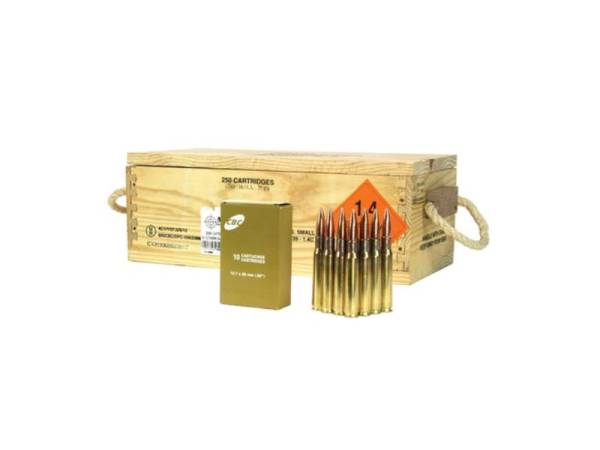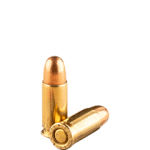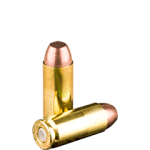Description
The .32 Smith & Wesson is a small pistol cartridge intended for use as personal protection at close range. The S&W Model 1½ break-top revolver was the first platform for the cartridge. Intended for use at “card table distances,” the .32 S&W was considered the smallest cartridge acceptable for personal protection in its time. It fit the bill for being a gentleman’s vest gun – a small handgun for the vest pocket that was especially popular in the late 19th century and early 20th century. It was later surpassed by the .32 ACP. The .32 S&W may also be referred to as the .32 S&W Short.
.32 S&W Short
Released by Smith & Wesson in 1878, the .32 S&W Short was popular from day one. While some low-quality revolvers were made to house the .32 Short, S&W chambered their break-open models for the round. Other companies followed suit, such as Colt, Hopkins & Allen, H&R, and Iver Johnson.
Due to low accuracy and power, the guns were more for show than for defense. The round spurred the “Saturday Night Special.” In addition to being an easily concealed weapon, the .32 became a favorite of small game hunters, plinkers, and target shooters. An 85-grain bullet, the most popular round, can still be found, but supplies are very scarce.
.32 S&W Long Cartridge
Introduced in 1896, the .32 S&W Long (7.65x23mm) is a centerfire, straight-walled, rimmed handgun round. The lengthened round was modeled after the .32 S&W cartridge and intended for use in S&W’s first issue Hand Ejector revolver. Colt, not keen to the idea of putting the S&W name on their product, dubbed their version the .32 Colt New Police.
Originally loaded with black powder, the cartridge was updated in 1903, and loaded with a smokeless powder while maintaining a similar chamber pressure.
Theodore Roosevelt, then the New York City Police Commissioner, adopted the Colt New Police revolver as the standard issue sidearm. Due to the ammunition’s reputation, several other police departments in the northeast followed suit. Unlike its less powerful counterpart, the .32 Long is a highly accurate cartridge. Colt began to produce the .32 S&W Long, but named their version the .32 “Colt’s New Police” cartridge because it supported their conversion of the .32 Long Colt to the Colt New Police revolver.
Additionally, they didn’t want to put their competitor’s name on one of their products. This was a common practice that would continue as new products were developed. Colt later renamed the .38 S&W to a .38 New Police Special.
.32 S&W Design
The .32 S&W was a black powder cartridge using nine grains of black powder. Originally designed by the Union Metallic Cartridge Co., the .32 S&W has been loaded exclusively with smokeless powder since 1940. The round is low-powered and designed for use in small, easily concealed derringers and revolvers. While the bullet wasn’t particularly effective, it remained popular throughout the U.S. and Europe, even after weapons chambered for it had ceased production.
There were several inexpensive break-top revolvers that were chambered for .32 bullets. Many were sold in mail-order catalogs for $3 to $4. The “steel” used to make the weapons was untreated soft iron with delicate lock-work components. Most of those guns still on the market are either inoperable or should not be fired.
Defensive Use
The .32 met the bare minimum requirement when it came to use for defensive purposes. In fact, it was deemed unsuitable for police use. However, the round nose bullet still had an edge over common calibers of the day.
Several other rimfire cartridges were introduced in the 1860s – ballistics were anemic, and the accuracy was nothing to write home about. Also unusual is the fact that the manufacturers were not concerned about long-range use at the time, as it was deemed irrelevant. The .32 S&W is often put into the same group with these ill-performing cartridges made for use in “belly guns,” or handguns meant to be used at point blank range in defensive situations such as those at a card table, in an alleyway, or a carriage.
.32 Colt Revolver Ammo
In 1875, Colt introduced its versions of the .32 Colt Short and .32 Colt Long cartridges, both designed to be chambered in their New Line .32 revolvers. At that time, Colt was the only American manufacturer chambering that caliber. However, it was being used in the United Kingdom, referred to as the .320 revolver.
The difference with Colt’s version was that they used a .30 caliber bullet that measured .300 instead of a bullet that measured .311 to .312, as was commonly used by other manufacturers of .32 revolvers. They attempted to use a heeled bullet, but it never gained popularity. As such, it was unable to top the .32 S&W round.
When it comes to interchangeability, it is not advisable to shoot a Colt .32 round in the Smith & Wesson. On the other side, the .32 S&W will not fit into a New Line .32 revolver.
.32-20 Revolver Cartridge
Introduced in 1882, the .32-20 is thought to be one of the more useful .32 caliber rounds. It was originally designed for the Model 73 Winchester rifle, but Colt and other major manufacturers eventually produced revolvers for it. Once thought to be interchangeable, it is recommended that only light loads be used in the revolvers to prevent injury or damage to the weapon, as the guns simply aren’t made for hot loads.
In 1984, Federal introduced a new style of the .32. To increase the power of the round, H&R lengthened the case and dubbed its new creation the .32 H&R Mag.
Ultimate .32 Revolver
The Ultimate .32 revolver, also known as the .327 Federal Magnum, was introduced in 2008 by Sturm, Ruger & Company and Federal Cartridge. The cartridge was designed to replace the .32 H&R Magnum for use in 6 shot, compact revolvers.
Its energy is similar to many cartridges used in the .357 Mag, and is a high-pressure round that outperforms the .32 H&R. Small game hunters like it for pest and varmint hunting. The increased power also makes it better suited for self defense.
Assassinations Using a .32
Since the .32 was an easily concealed weapon and made little noise, it is not surprising that assassins would choose the pocket pistol to do their dirty work. What is surprising is that the .32 was powerful enough to kill, even at close range. However, the following assassinations, using the .32, were successful:
On July 29, 1900, King Umberto I of Italy was assassinated in Monza by Gaetano Bresci. Bresci, an anarchist, shot King Umberto “The Good” four times with a .32 S&W Iver-Johnson revolver.
On September 6, 1901, Leon Czolgouz shot U.S. President William McKinley with an Iver Johnson revolver chambered for a .32 S&W. The first shot fired was deflected by a button on McKinley’s shirt. The second shot penetrated McKinley’s abdomen at close range. The bullet did not kill McKinley, but he developed an infection and, eventually, gangrene. President McKinley died on September 14, 1901.
On February 15, 1933, Chicago Mayor Anton Cermak was fatally shot by Giuseppe Zangara during a political rally. Zangara, sporting a .32 S&W revolver, attended the rally in Miami with the intention of assassinating Franklin D. Roosevelt. Cermak was shaking hands with FDR when Zanagara made his move. Zangara’s aim was foiled at the last minute, and Cermak was hit in the lung. Four other people were also struck, one of whom died. Cermak died two weeks later of his injuries.
On September 8, 1935, U.S. Senator Huey “Kingfish” Long was at the Louisiana State Capitol in Baton Rouge attempting to oust long-time opponent, Judge Benjamin Pavy. Moments after Long achieved his victory, Pavy’s son-in-law, Dr. Carl Weiss, approached Long and shot him in the torso at close range with an FN Model 1910 .32 ACP semi-auto pistol. Weiss was gunned down by security; Long succumbed to his injuries two days later.
On June 5, 1968, U.S. Senator and presidential candidate Robert F. Kennedy was shot and killed in a Los Angeles hotel by Sirhan Sirhan. Sirhan used an 8-shot Iver Johnson .22 caliber Cadet 55-A revolver. Kennedy was shot three times, and five others were wounded. RFK died the following day.
From October 1973 to April 1974, San Francisco was under siege by a group of male Black Muslims, known as the “Death Angels.” The men kidnapped and committed 15 murders and eight attempted murders against white citizens, all racially motivated. The “Zebra” murders were eventually solved when the killers were linked to a .32 pistol used to carry out the crimes.
On October 26, 1979, Park Chung-hee, president of South Korea, was assassinated during a dinner at a Korean Central Intelligence Agency (KCIA) safehouse inside the Blue House presidential compound. Kim Jae-gyu, Director of the KCIA and the president’s security chief, shot Park in the chest and head with a Walther PPK .32. Park died almost instantly. Park’s chauffeur and four bodyguards were also killed.
.32 Chambered Handguns
While many .32 chambered handguns are scarce, there are some still on the market. Collectors and firearms enthusiasts are warned, however, that many of the guns were made from weak materials and should not be fired.
North American Arms Guardian .32 ACP
The North American Arms Guardian (NAA) was launched in 1997. NAA had been known for its mini-revolvers chambered in .22 caliber, so the .32 was a new venture for the company. Influenced by the Seecamp pistol line, the Guardian uses a fixed barrel and direct blowback action. The frame, slide, and fixed barrel are machined using 17-4 PH stainless steel.
Kel-Tec P-32
In 1999, Kel-Tec introduced the P-32, a locked-breech semi-auto pistol. The slide and barrel are machined from SAE 4140 ordnance steel, with an internal frame made with 7075-T6 aluminum. The checkered grip, external frame, and trigger are made from ultra-high-impact polymer. This combination of materials creates a pistol so light that Kel-Tec offers a lanyard for the user to wear the weapon around his neck.
Iver Johnson Safety Automatic “New Model”
From 1871 to 1993, Iver Johnson operated as a U.S. firearms, bicycle, and motorcycle manufacturer. Here, Johnson manufactured a top-break revolver known as a Safety Automatic. Despite the name, the gun is a revolver, not a semi-auto. The moniker instead refers to the hammer-the-hammer transfer bar safety system and the automatic ejection of the cartridge upon breaking open the revolvers. The New Model was chambered for various calibers including the .22, .32 Long and the .38 S&W.
Union Automatic Revolver
The Union Firearms Company of Toledo, Ohio, introduced its recoil-operated, semi-automatic revolver in 1908. Known as the Union Automatic Revolver, this .32 caliber firearm was designed by Charles F. Lefever and is often referred to as the Lefever Revolver. The gun is similar to the Webley Fosbery automatic revolver, but features a shroud that protected the user’s hand from recoil. It was produced until 1912, when the Union Firearms Company went out of business.
Henrion, Dassy & Heuschen Revolver
In 1910, Belgian firearms manufacturers Henrion, Dassy & Heuschen introduced a double-barrel revolver with two concentric sets of chambers, each serving its individual barrel. The weapon was fired using a single hammer with two firing pins. Because the chambers were staggered, the revolver only fired one round at a time. These revolvers were produced in various calibers.
Smith & Wesson New Departure
In 1887, Smith & Wesson introduced The Smith & Wesson New Departure or The Smith & Wesson Safety Hammerless (nicknamed “The Lemon Squeezer”). The revolver is a double-action gun that was manufactured from 1887 to 1940. Based on the S&W Model 2 double action, the New Departure incorporated an external grip safety on its back-strap as well as an internal hammer. It was chambered for .32 S&W and .38 S&W calibers. The revolvers were produced until the advent of World War II, when they were replaced by stronger hand-ejector models.
Smith & Wesson Model 1½
The Smith & Wesson Model 1 1/2 was Smith & Wesson’s second .32 caliber revolver, intended to combine the small size and convenience of the .22 caliber Model 1 with the larger caliber of the 6-shot “belt sized” Model 2, which was introduced in 1860. Chambered in .32 Rimfire, its cylinder held five shots. It was produced in three varieties from 1865 through 1892, with total production exceeding 223,000.
Merwin Hulbert Small Frame Revolvers
Based in New York City, Merwin, Hulbert, and Co. was an American firearms designer and marketer, producing designs for rifles and revolvers from 1876 through 1916. The guns were manufactured by their subsidiary company, Hopkins & Allen in Norwich, Connecticut.
Merwin Hulbert responded to the call for a smaller and lighter weapon by producing a Small Frame Pocket Model. The gun was a five-shot chambered in a .32 M&H caliber. Comparable to Merwin Hulbert’s 4th Model Pocket, the revolver was available in both single and double action, with or without a folder hammer spur.





